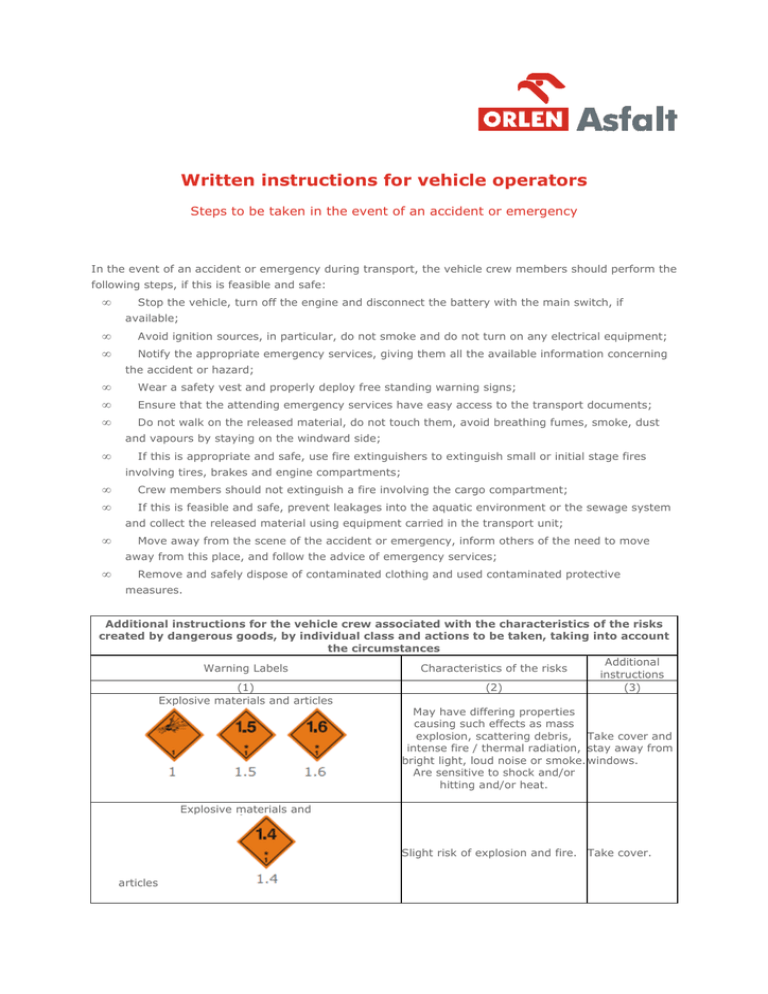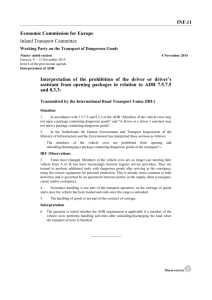Written instructions for vehicle operators
advertisement

Written instructions for vehicle operators Steps to be taken in the event of an accident or emergency In the event of an accident or emergency during transport, the vehicle crew members should perform the following steps, if this is feasible and safe: • Stop the vehicle, turn off the engine and disconnect the battery with the main switch, if available; • • Avoid ignition sources, in particular, do not smoke and do not turn on any electrical equipment; Notify the appropriate emergency services, giving them all the available information concerning the accident or hazard; • Wear a safety vest and properly deploy free standing warning signs; • Ensure that the attending emergency services have easy access to the transport documents; • Do not walk on the released material, do not touch them, avoid breathing fumes, smoke, dust and vapours by staying on the windward side; • If this is appropriate and safe, use fire extinguishers to extinguish small or initial stage fires involving tires, brakes and engine compartments; • • Crew members should not extinguish a fire involving the cargo compartment; If this is feasible and safe, prevent leakages into the aquatic environment or the sewage system and collect the released material using equipment carried in the transport unit; • Move away from the scene of the accident or emergency, inform others of the need to move away from this place, and follow the advice of emergency services; • Remove and safely dispose of contaminated clothing and used contaminated protective measures. Additional instructions for the vehicle crew associated with the characteristics of the risks created by dangerous goods, by individual class and actions to be taken, taking into account the circumstances Additional Warning Labels Characteristics of the risks instructions (1) (2) (3) Explosive materials and articles May have differing properties causing such effects as mass explosion, scattering debris, Take cover and intense fire / thermal radiation, stay away from bright light, loud noise or smoke. windows. Are sensitive to shock and/or hitting and/or heat. Explosive materials and Slight risk of explosion and fire. Take cover. articles Additional instructions for the vehicle crew associated with the characteristics of the risks created by dangerous goods, by individual class and actions to be taken, taking into account the circumstances Flammable gases Risk Risk May Risk May Risk of fire. of explosion. be under pressure. of suffocating effect. cause burns or frostbite. of explosion if heated. Risk May May Risk of suffocating effect. be pressurised. cause frostbite. of explosion if heated. Take cover. Avoid low areas. Non-flammable and non-toxic Take cover. Avoid low areas. gases Risk of poisoning. May be pressurised. May cause chemical burns or frostbite. Risk of explosion if heated. Toxic substances Use escape mask. Take cover. Avoid low areas. Flammable Risk of fire. Risk of explosion. Risk of explosion if heated. Take cover. Avoid low areas. liquids Flammable solids, self-reactive substances and solid desensitized explosives Risk of fire. Flammable or combustible materials. May be ignited by heat, sparks or open flame. May contain self-reactive substances, which can decompose exothermically as a result of providing heat, contact with other materials (such as acids, heavy metal compounds or amines), friction or impact. As a result of decomposition may produce noxious and flammable vapours or gases, or spontaneous combustion may occur. Risk of explosion if heated. Risk of explosion of desensitized explosive materials in the case of loss of desensitization substance. Spontaneously combustible materials Substances, which emit flammable gases in contact Risk of fire due to spontaneous combustion in the event of damage to packages or release of the contents. May react violently with water. RRisk of fire and explosion on contact with water. Released material should Additional instructions for the vehicle crew associated with the characteristics of the risks created by dangerous goods, by individual class and actions to be taken, taking into account the circumstances be kept dry and covered. with water Oxidizing Avoid mixing Risk of violent reaction, fire and with explosion in the event of contact combustible with combustible materials. materials (e.g.: sawdust) substances Danger of exothermic decomposition at elevated temperature by contact with other materials (such as acids, Avoid mixing heavy metal compounds or with combustible amines), friction or impact. As a result of decomposition may materials (e.g.: produce noxious and flammable sawdust) vapours or gases, or spontaneous combustion may occur. Organic peroxides Risk of poisoning by inhalation, skin contact or ingestion. Danger in case of seepage into water or sewage. Toxic substances Use escape mask. Infectious Risk of infection. May cause a dangerous disease in humans or animals.Danger in case of seepage into water or sewage. substances Radioactive Risk of absorption and external irradiation. materials Limit time of exposure. Additional instructions for the vehicle crew associated with the characteristics of the risks created by dangerous goods, by individual class and actions to be taken, taking into account the circumstances Risk of chain reaction. Fissile material Corrosive substances Risk of chemical burn. May react violently with each other, with water or other materials. The released materials may give off corrosive vapours. Risk in the event of seepage into a water course or sewage system. Miscellaneous dangerous goods Risk of burns. Risk of fire. Risk of explosion. Risk in the event of seepage into a water course or sewage system. ATTENTION 1: In the case of dangerous goods with more than one risk and for mixed loads each of the specified instructions shall be used. ATTENTION 2: Additional information referred to above may be modified to adapt them to the classes of dangerous goods intended for transport and the means of transport used. Additional information for crew members on the characteristics of the hazards of dangerous goods marked with the symbols and proceedings depending on the circumstances Symbol Characteristics of the risks Additional instructions (1) (2) (3) Danger in case of seepage into water or sewage Risk of burning. Avoid contact with hot parts of the transport unit and the released material. Personal protective equipment and general safety equipment for general operations and rescue operations specific to the type of risk, transported in the vehicle in accordance with regulation 8.1.5 ADR The following equipment should be kept in the vehicle during the transport of hazardous goods for all warning label numbers: • The following equipment should be kept in the vehicle during the transport of hazardous goods for all warning label numbers: • • two free-standing warning signs; a eye rinsing liquid : In addition, the following should be provided for each member of the vehicle's crew: • a safety vest (e.g. as described in EN 471); • portable lighting; • • a pair of protective gloves; eye protection (e.g. goggles). Additional equipment for certain classes: • b an escape mask for each member of the vehicle crew should be kept in the vehicle during the transport of Class 2.3 or 6.1 goods; • a shovel ; • a manhole cover ; • container to collect residues . c c c -----------------------a Not required in warning label numbers 1, 1.4, 1.5, 1.6, 2.1, 2.2 or 2.3. b For example, an escape mask with a composite absorber for gas or dust of the A1B1E1K1-P1 or A2B2E2K2-P2 type, similar to the one described in the EN 141 standard. c Only required in the case of warning labels 3, 4.1, 4.3, 8 and 9.
